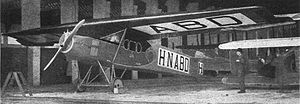Fokker F.I (airliner)
| F.II | |
|---|---|
 |
|
| the third F.II | |
| Role | Airliner |
| Manufacturer | Fokker |
| Designer | Reinhold Platz |
| First flight | October 1919 |
| Retired | 1934 |
| Primary users |
Deutsche Aero Lloyd Deutsche Luft Hansa, KLM |
| Number built | about 23 |
| Variants | Fokker F.III |
The Fokker F.II was the first of a long series of commercial aircraft from the Fokker Aircraft Company, flying in 1919. In a biplane age, it presented a distinct clean, high-wing monoplane style that sold successfully across Europe and North America during the development of commercial passenger-carrying aviation.
The Fokker F.II was a single engined high-wing cantilever monoplane with a design lineage that went back to designer Reinhold Platz's Dr.I triplane, via the biplane D.VII and monoplane D.VIII fighters and his unflown F.I civil design. The Dr.I was the first aircraft to use the thick high lift/drag airfoils that enabled high climb rates and also allowed internal wing bracing. Hence the triplane wing needed no external wire bracing and its monoplane successors, apart from attachments to the fuselage were simple cantilever structures.
The F.II had other characteristic early-Fokker design features: a wing constructed of wood, fully skinned in plywood, with ailerons extending beyond the wingtips and a deep sided square section fuselage of welded steel tube covered in fabric which provided enough directional stability that no vertical fin was fitted. The F.II had a fixed undercarriage, the main units of which were joined by a cross-axle.
There was enclosed accommodation for four passengers; a fifth could travel alongside the pilot in his unenclosed cockpit, in a seat originally intended for a mechanic or navigator.
The prototype F.II, known by the company designation V.45, was constructed at the Fokker factory in Schwerin, Germany, and made its first flight there in October 1919. When Anthony Fokker decided to relocate the firm to the Netherlands, the V.45 was illegally flown across the border on 20 March 1920. Even after this, perhaps another three examples were built at Schwerin before production shifted to Veere. The prototype was powered by a 138 kW (185 hp) BMW IIIa. This proved to have cooling problems, and after an experiment with a 133 kW (178 hp) Mercedes motor, KLM who took this machine as one of two they ordered fitted it with a 179 kW (240 hp) Armstrong Siddeley Puma. Their second F.II was similarly re-engined.
...
Wikipedia
